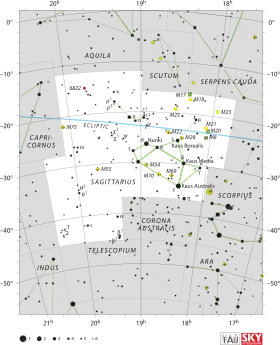Chi3 Sagittarii
Chi3 Sagittarii (χ3 Sagittarii) is a solitary,[11] orange-hued star in the zodiac constellation of Sagittarius. It is faintly visible to the naked eye with an apparent visual magnitude of +5.45.[2] Based upon an annual parallax shift of 6.53 mas as seen from Earth,[1] it is located roughly 500 light years from the Sun. It is receding from the Earth with a radial velocity of 39.6 km/s.[5]

| |
| Observation data Epoch J2000.0 Equinox J2000.0 (ICRS) | |
|---|---|
| Constellation | Sagittarius |
| Right ascension | 19h 25m 29.65949s[1] |
| Declination | −23° 57′ 44.8390″[1] |
| Apparent magnitude (V) | +5.448[2] |
| Characteristics | |
| Spectral type | K3 III[3] |
| U−B color index | +1.662[2] |
| B−V color index | +1.443[2] |
| Variable type | suspected[4] |
| Astrometry | |
| Radial velocity (Rv) | +39.6[5] km/s |
| Proper motion (μ) | RA: −18.66[1] mas/yr Dec.: −12.73[1] mas/yr |
| Parallax (π) | 6.53 ± 0.42[1] mas |
| Distance | 500 ± 30 ly (153 ± 10 pc) |
| Absolute magnitude (MV) | −0.46[6] |
| Details | |
| Radius | 37[7] R☉ |
| Luminosity | 301[8] L☉ |
| Surface gravity (log g) | 1.860[9] cgs |
| Temperature | 4,040[9] K |
| Metallicity [Fe/H] | −0.10[9] dex |
| Other designations | |
| Database references | |
| SIMBAD | data |
This is an evolved, K-type giant star with a stellar classification of K3 III.[3] It is a suspected optical variable star with a magnitude range of 5.42 to 5.46.[4] At infrared wavelengths, it shows large amplitude variation with a period of 505 days.[12] The star has expanded to about 37[7] times the Sun's radius and is radiating 301[8] times the solar luminosity from its photosphere at an effective temperature of 4,040 K.[9]
References
- van Leeuwen, F. (2007), "Validation of the new Hipparcos reduction", Astronomy and Astrophysics, 474 (2): 653–664, arXiv:0708.1752, Bibcode:2007A&A...474..653V, doi:10.1051/0004-6361:20078357.
- Celis S., L. (October 1975), "Photoelectric photometry of late-type variable stars", Astronomy and Astrophysics Supplement Series, 22: 9–17, Bibcode:1975A&AS...22....9C.
- Houk, Nancy; Smith-Moore, M. (1978), Michigan catalogue of two-dimensional spectral types for the HD stars, 4, Ann Arbor: Dept. of Astronomy, University of Michigan, Bibcode:1988mcts.book.....H.
- Samus, N. N.; Durlevich, O. V.; et al. (2009). "VizieR Online Data Catalog: General Catalogue of Variable Stars (Samus+ 2007-2013)". VizieR On-line Data Catalog: B/gcvs. Originally Published in: 2009yCat....102025S. 1. Bibcode:2009yCat....102025S.
- Evans, D. S. (June 20–24, 1966), Batten, Alan Henry; Heard, John Frederick (eds.), "The Revision of the General Catalogue of Radial Velocities", Determination of Radial Velocities and their Applications, Proceedings from IAU Symposium no. 30, University of Toronto: International Astronomical Union, 30, p. 57, Bibcode:1967IAUS...30...57E.
- Anderson, E.; Francis, Ch. (2012), "XHIP: An extended hipparcos compilation", Astronomy Letters, 38 (5): 331, arXiv:1108.4971, Bibcode:2012AstL...38..331A, doi:10.1134/S1063773712050015.
- Pasinetti Fracassini, L. E.; et al. (2001), "Catalogue of Apparent Diameters and Absolute Radii of Stars (CADARS)", Astronomy and Astrophysics (Third ed.), 367 (2): 521, arXiv:astro-ph/0012289, Bibcode:2001A&A...367..521P, doi:10.1051/0004-6361:20000451.
- McDonald, I.; et al. (2012), "Fundamental Parameters and Infrared Excesses of Hipparcos Stars", Monthly Notices of the Royal Astronomical Society, 427 (1): 343–57, arXiv:1208.2037, Bibcode:2012MNRAS.427..343M, doi:10.1111/j.1365-2966.2012.21873.x.
- Soubiran, C.; et al. (June 2010), "The PASTEL catalogue of stellar parameters", Astronomy and Astrophysics, 515: A111, arXiv:1004.1069, Bibcode:2010A&A...515A.111S, doi:10.1051/0004-6361/201014247.
- "chi03 Sgr". SIMBAD. Centre de données astronomiques de Strasbourg. Retrieved 2017-07-04.
- Eggleton, P. P.; Tokovinin, A. A. (September 2008), "A catalogue of multiplicity among bright stellar systems", Monthly Notices of the Royal Astronomical Society, 389 (2): 869–879, arXiv:0806.2878, Bibcode:2008MNRAS.389..869E, doi:10.1111/j.1365-2966.2008.13596.x.
- Price, Stephan D.; et al. (October 2010), "3.6 Years of DIRBE Near-infrared Stellar Light Curves", The Astrophysical Journal Supplement, 190 (2): 203, Bibcode:2010ApJS..190..203P, doi:10.1088/0067-0049/190/2/203, 203−219.